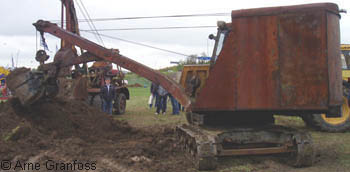Norwegian civil bases in Sweden

 UNDER CONSTRUCTION Version 0.11
UNDER CONSTRUCTION Version 0.11
|
Sweden in World War II - across borders
|
 |
![]()
![]()
During one of the first meetings of the fleeing Norwegian government after the German attack on 9 April, they saw Stockholm as a solution
for necessary Norwegian contacts for foreign affaires. The president of the Norwegian parliament, C J Hambro, was sent to Stockholm. Norway also had a
small hope to purchase ammunition, weapons and other equipment in Sweden. Maybe the Swedish neutrality would be handled in the same way that the neutral Norway acted when Finland was attacked by the Soviet Union? [s01]
The national Norwegian radio had been captured by the Germans on 9 April, and the telephone network in Norway was out of order. However, the Norwegian legation in Stockholm could have telephone contact both with Oslo, the fleeing government and other civilian and military officials in Norway. Therefore messages between officials in Norway, and between Norway and Norwegian legations around the globe, were verbally relaid via Stockholm for a month. [s01]
The Norwegian legation in Stockholm grew as more and more functions were established, and over time more offices were hired in Stockholm. Lots of matters had to be handled, besides the normal peacetime activities. There were hundreds of young refugees who wanted to be sent back to northern Norway where they would join the Norwegian troops, thousands of Norwegian soldiers who had chosen to cross the border and hope to fight another day instead of surrender to Germany, Norwegian ships and sailors in Swedish ports, contracts with Swedish ship yards, purchase of equipment and wares to be sent to people in Norway who were suffering after the German attacks, et cetera. [s01]
There were daily morning meetings at the legation. On 14 May 1940 among others these matters were discussed:
- Around 500 British and some French women and children in Finland and Sweden would be transported home to Britain via Kirkenes in northern Norway.
Could Norway help with the transport and accomodation in Norway?
- Some 50 Norwegians who came to Sweden in civilian clothes had been detained, and their skis and supplies confiscated.
- How to use the money from voluntary funds and gifts. Among the gifts were 100 000 Swedish kronor from Wallenberg and a gift from Stockholm municipality, for aid to people in Norway.
- Swedish cinemas had performances for the benefit of Norway, and contacts for more.
- Purchase of ammunition in Sweden, where they thought private companies would be the most probable suppliers. It was thought that it should be paid in cash, since Swedes seemed to think that Norway lacked money to pay with [s01]
Among the other activities was to use the around 500 Norwegian cars that were in Sweden before 9 April, for transports of aid to Norway. Also trucks were sent to the area Nordtrøndelag before the Norwegian troops before the Norwegian troops capitulated there. Norwegian railway vehicles were also taken care of, among others for use in transports of Norwegian refugees. [s01]
There were several meetings in Stockholm between the Norwegians and foremost the British, to plan the large British navy attack on Norway and to free the city Trondheim from German occupation. Among others maps and interpreters were sent to Britain by plane. Also Norwegian bank notes were bought in Sweden and sent to Britain for use by the Allied troops when they came to northern Norway. (The large attack never took place, and neither advices nor warnings from the meetings in Stockholm were used in the smaller Allied operations that took place.) [s01]
Among all the Norwegian activities in Stockholm between April and June, was the work to keep the Norwegian merchant fleet under Norwegian control. It was in 1940 the fourth largest on the planet. The cooperation with the legations in London and Washington, shipping companies, captains and sailors, gave the result that 85% of the 1200 ships remained under Norwegian flag. [s01]
The Norwegian government never asked the Swedish government for any help or support during this period, and they never received any. [s01]
![]()
The official hub for contacts between the Norwegian government in London and the Swedish government was the Norwegian legation in Stockholm. It was also the hub for communication with the Norwegian Hjemmefront (home front) in Norway.
During the first one and a half year there were also two members of the Norwegian government in Stockholm, who did not act under the legation. This was not always positive. [s36]
![]()
Norwegian authorities initiated Pressekontoret (press office) in Stockholm in summer 1941, for contacts with Norwegian government's partner Kretsen (a group of people) in Oslo. [s03]
![]()
In September 1942 the Norwegian Minister of Justice initiate a reorganisation of the Norwegian legation in Stockholm, to work for less sabotage in Norway. [s03]
![]()
An agreement was made on 9 October 1942 between the Norwegian legation in Stockholm and Swedish intelligence organisation, about supervision of nazis and communists at the Norwegian refuge reception in Kjesäter near Stockholm. [s03]
![]()
![]()
![]()
In the summer of 1944 the Norwegian king and prime minister shared received letters with delicate texts from Norway, sent via Stockholm.
Both thought it was very unsuitable to send such texts via the Swedish and British censor functions. [s36]
In the autumn representatives for the Norwegian government visited among others Stockholm and Moscow, but made some activities that were not according to the view of the Norwegian government. Among others discussions about a loan from Sweden to Norway for financial support for the costs Norway had for refugees and training of Norwegian policemen in Sweden. The Norwegian government did not want such a loan. [s36]
![]()
2011-12-22. www.granfoss.se. Text/pictures: Arne Granfoss